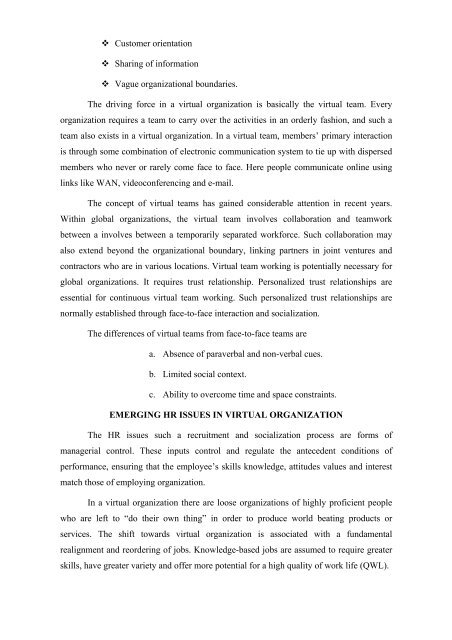UNIT – I Lesson 1 HRM – AN OVERVIEW Lesson Outline Nature of ...
UNIT – I Lesson 1 HRM – AN OVERVIEW Lesson Outline Nature of ...
UNIT – I Lesson 1 HRM – AN OVERVIEW Lesson Outline Nature of ...
You also want an ePaper? Increase the reach of your titles
YUMPU automatically turns print PDFs into web optimized ePapers that Google loves.
� Customer orientation<br />
� Sharing <strong>of</strong> information<br />
� Vague organizational boundaries.<br />
The driving force in a virtual organization is basically the virtual team. Every<br />
organization requires a team to carry over the activities in an orderly fashion, and such a<br />
team also exists in a virtual organization. In a virtual team, members’ primary interaction<br />
is through some combination <strong>of</strong> electronic communication system to tie up with dispersed<br />
members who never or rarely come face to face. Here people communicate online using<br />
links like W<strong>AN</strong>, videoconferencing and e-mail.<br />
The concept <strong>of</strong> virtual teams has gained considerable attention in recent years.<br />
Within global organizations, the virtual team involves collaboration and teamwork<br />
between a involves between a temporarily separated workforce. Such collaboration may<br />
also extend beyond the organizational boundary, linking partners in joint ventures and<br />
contractors who are in various locations. Virtual team working is potentially necessary for<br />
global organizations. It requires trust relationship. Personalized trust relationships are<br />
essential for continuous virtual team working. Such personalized trust relationships are<br />
normally established through face-to-face interaction and socialization.<br />
The differences <strong>of</strong> virtual teams from face-to-face teams are<br />
a. Absence <strong>of</strong> paraverbal and non-verbal cues.<br />
b. Limited social context.<br />
c. Ability to overcome time and space constraints.<br />
EMERGING HR ISSUES IN VIRTUAL ORG<strong>AN</strong>IZATION<br />
The HR issues such a recruitment and socialization process are forms <strong>of</strong><br />
managerial control. These inputs control and regulate the antecedent conditions <strong>of</strong><br />
performance, ensuring that the employee’s skills knowledge, attitudes values and interest<br />
match those <strong>of</strong> employing organization.<br />
In a virtual organization there are loose organizations <strong>of</strong> highly pr<strong>of</strong>icient people<br />
who are left to “do their own thing” in order to produce world beating products or<br />
services. The shift towards virtual organization is associated with a fundamental<br />
realignment and reordering <strong>of</strong> jobs. Knowledge-based jobs are assumed to require greater<br />
skills, have greater variety and <strong>of</strong>fer more potential for a high quality <strong>of</strong> work life (QWL).
















